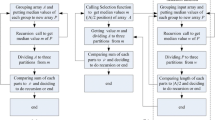Abstract
This paper presents a greedy algorithm for decomposing convex structuring elements as sequence of Minkowski additions of subsets of the elementary square (i.e., the 3 × 3 square centered at the origin). The technique proposed is very simple and it is based on algebraic and geometric properties of Minkowski additions. Besides its simplicity, the advantage of this new technique over other known algorithms is that it generates a minimal sequence of not necessarily convex subsets of the elementary square. Thus, subsets with smaller cardinality are generated and a faster implementation of the corresponding dilations and erosions can be achieved. Experimental results, proof of correctness and analysis of computational time complexity of the algorithm are also given.
Similar content being viewed by others
References
G. Anelli, A. Broggi, and G. Destri, “Decomposition of arbitrarily shaped binary morphological structuring elements using genetic algorithms,” IEEE Transactions on Pattern Analysis and Machine Intelligence, Vol. 20, No. 2, pp. 217–224, 1998.
S. Baase, Computer Algorithms, Addison-Wesley, 1988.
G.J.F. Banon and J. Barrera, “Minimal representations for translation-invariant set mappings by mathematical morphology,” SIAM J. Appl. Math., Vol. 51, No. 6, pp. 1782–1798, 1991.
G.J.F. Banon and J. Barrera, “Decomposition of mappings between complete lattices by mathematical morphology, Part I. General lattices,” Signal Processing,Vol. 30, pp. 299–327, 1993.
J. Barrera, G.J.F. Banon, R.A. Lotufo, and R. Hirata Jr, “MMach: A mathematical morphology toolbox for the Khoros system,” Electronic Imaging, Vol. 7, No. 1, pp. 174–210, 1998.
J. Barrera, R. Terada, R. Hirata, and N.S.T. Hirata, “Automatic programming of morphological machines by PAC learning,” Fundamenta Informaticae,Vol. 41, Nos. 1/2, pp. 229–258, 2000.
O.I. Campos, T. Kanungo, and R. Haralick, “Gray-scale structuring element decomposition,” IEEE Transactions on Image Processing, Vol. 5, No. 1, pp. 111–120, 1996.
T.H. Cormen, C.E. Leiserson, and R.L. Rivest, Introduction to Algorithms, McGraw-Hill, 1990.
H. Freeman, “Computer processing of line-drawing Images,” Computer Surveys, Vol. 6, No. 1, pp. 57–97, 1974.
P. Gader, “Separable decompositions and approximations for gray-scale morphological templates,” Computer Vision, Graphics, and Image Processing, Vol. 53, pp. 288–296, 1991.
P. Gader and E.G. Dunn, “Image algebra and morphological template decomposition,” Orlando, Florida, March 1989 SPIE Proceedings, Vol. 1098, pp. 134–145.
P. Gader and S. Takriti, “Decomposition techniques for gray-scale morphological templates,” July 1990, SPIE Press, Vol. 1350, pp. 431–442.
R.C. Gonzalez and R.E. Woods, Digital Image Processing, Addison-Wesley, 1992.
R.F. Hashimoto and J. Barrera, “A note on Park and Chin's algorithm,” IEEE Transaction on Pattern Analysis and Machine Intelligence, Vol. 24, No. 1, pp. 139–144, 2002.
R.F. Hashimoto, J. Barrera, and C.E. Ferreira, “A combinatiorial optimization technique for the sequential decomposition of erosions and dilations,” Journal of Mathematical Imaging and Vision, Vol. 13, No. 1, pp. 17–33, 2000.
H.J.A.M. Heijmans, Morphological Image Operators, Academic Press, 1994.
T. Kanungo and R. Haralick, “Vector-space solution for a morphological shape-decomposition problem,” Journal of Mathematical Imaging and Vision, Vol. 2, pp. 51–82, 1992.
D. Li, “Morphological template decomposition with Maxpolynomials,” Journal of Mathematical Imaging and Vision, Vol. 1, No. 3, pp. 215–221, 1992.
D. Li and G.X. Ritter, “Decomposition of separable and symetric convex templates,” in Image Algebra and Mathematical Morphology, San Diego, California, 1990, SPIE Proceedings, Vol. 1350, pp. 408–418.
P.A. Maragos, “A unified theory of translation-invariant systems with applications to morphological analysis and goding of images,” Ph.D. Thesis, School of Elect. Eng., Georgia Inst. Tech., 1985.
H. Park and R.T. Chin, “Optimal decomposition of convex morphological structuring elements for 4-connected parallel processors,” IEEE Transactions on Pattern Analysis and Machine Intelligence, Vol. 16, No. 3, pp. 304–313, 1994.
H. Park and R.T. Chin, “Decomposition of arbitrarily shaped morphological structuring elements,” IEEE Transactions on Pattern Analysis and Machine Intelligence,Vol. 17, No. 1, pp. 2–15, 1995.
T. Pavlidis, Algorithms for Graphics and Image Processing, Computer Science Press, Rockville, MD, 1982.
C.H. Richardson and R. Schafer, “A lower bound for structuring element decompositions,” IEEE Transactions on Pattern Analysis and Machine Intelligence, Vol. 13, No. 4, pp. 365–369, 1991.
J. Serra, Image Analysis and Mathematical Morphology, Academic Press, 1982.
P. Sussner, P.M. Pardalos, and G.X. Ritter, “On integer programming approaches for morphological template decomposition problems in computer vision,” Journal of Combinatorial Optimization, Vol. 1, No. 2, pp. 165–178, 1997.
P. Sussner and G.X. Ritter, “Decomposition of gray-scale morphological templates using the Rank method,” IEEE Transactions on Pattern Analysis and Machine Intelligence, Vol. 19, No. 6, pp. 649–658, 1997.
P. Sussner and G.X. Ritter, “Rank-based decompositions of morphological templates,” IEEE Transactions on Image Processing, Vol. 9, No. 8, 2000.
S. Takriti and P. Gader, “Local decomposition of gray-scale morphological templates,” Journal of Mathematical Imaging and Vision, Vol. 2, pp. 39–50, 1992.
R. van den Boomgaard and R. van Balen, “Methods for fast morphological image transforms using bitmapped binary images,” CVGIP-Graphical Models and Image Processing,Vol. 54, No. 3, pp. 252–258, 1992.
J. Xu, “Decomposition of convex polygonal morphological structuring elements into neighborhood subsets,” IEEE Transactions on Pattern Analysis and Machine Intelligence, Vol. 13, No. 2, pp. 153–162, 1991.
H. Yang and S. Lee, “Optimal decomposition of morphological structuring elements,” in Proceedings of IEEE International Conference on Image Processing, Lausanne-Switzerland,IEEE Computer Society, 1996, Vol. 3, pp. 1–4.
X. Zhuang and R. Haralick, “Morphological structuring element decomposition,” ComputerVision, Graphics, and Image Processing, Vol. 35, pp. 370–382, 1986.
Author information
Authors and Affiliations
Rights and permissions
About this article
Cite this article
Hashimoto, R.F., Barrera, J. A Greedy Algorithm for Decomposing Convex Structuring Elements. Journal of Mathematical Imaging and Vision 18, 269–289 (2003). https://doi.org/10.1023/A:1022847527229
Issue Date:
DOI: https://doi.org/10.1023/A:1022847527229




